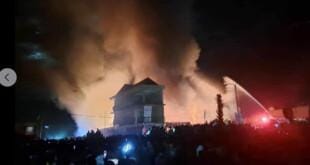Persecuted at Home, Harassed and Abused Abroad By Mohammed Isa (@hanifkoo)
The indiscriminate round-up and detention against all immigrants who have been in the country began on Friday April 2, 2014; and has mainly targeted the immigrants living in Eastleigh District of Nairobi, a neighborhood largely dominated by Somalis and Oromo immigrants. Oromo refugees once fled to Kenya for safety claim facing detention and threats since government ordered them to move to camps. The Kenyan police and security agents have arbitrary arrested and detained around 6000 refugees who are originally from neighboring Horn of African countries; and have continued hunting for more.
During the last two decades millions of oromos fled their country and living as a refugee in different parts of the world to escape the brutal mental and physical torture of the current TPLF led regime of Ethiopia. To be honest, since the time is immemorial Kenyan and Oromo co- habited and relatively had have harmonious and brotherly relationship. As part of the war against Oromo at home and living as refugee abroad, the regime introduced divisive and wrong political policy and agenda in the region, which in turn harmed the relation between oromo and its neighbors. In addition, during the last two decades, staged dozens of cross-border raids into the neighboring countries of Kenya and Somalia and hunted down, kidnapped or killed thousands of Oromos including many Kenyan citizens.
In the space of little more than a week, more than 400 Oromos and other Ethiopian immigrants have been arrested in these crackdown(HRLHA April 14, 2014). The crackdowns against immigrants by Kenyan Police and security began is said to been in response to the three bomb blasts in Eastleigh/ Nairobi and Mombasa in late March 2014, which killed about 12 people and injured 8 others. According to HRLHA’s informant, more than two thousand asylum seekers and refugees have been detained in the Kasarani Football Stadium in the Capital, a location described as a temporary police station, while some are being held at the Pangani police station.
According to UNHCR’s statistics and figures, there are 56,000 asylum seekers and refugees registered with the UN refugee agency UNHCR in Nairobi and other urban centers in Kenya (UNHCR, 2013). These include 33,844 Somalis, 10,568 Ethiopians, and nationals from the Democratic Republic of the Congo, Eritrea and South Sudan. Most of Oromo and other urban refugees who came from neighboring countries live in Eastleigh district of Nairobi. Just east of Nairobi’s centre, Eastleigh is one of the city’s most vibrant business districts and home to many Somali and oromo refugees.
Speaking to VOA Afaan oromo, Roba, who fled Ethiopia’s Oromia region for Kenya in 2005 and now has been detained at kasarani detention center for 10 days, echoed these calls. “Most of detained refugees have a legal mandate and allein ID and The UNHCR allowed us to be here,” he says, arguing that the international community and agency should now speak out forcefully against Kenya’s illegal detention. Asked if he could go back to Ethiopia, after silence of a minute, taking a short breaths of surprise, He said “he had been killed” if he returned to his country.
The terrorist threat is unquestionable. Kenya must have to put a clear fine- line between combating terrorism and dealing with illegal immigrant issues. To be true, given Kenya’s being the target of planned and multi-pronged attack, the recent crackdown and operation on illegal immigrant and innocent refugees could not be called more than blanket actions that look like collective punishment of a refugees and asylum seekers. Last year Kenya’s government concerted decisions to return all refugees to overcrowded refugee camps halted at the eleventh hour by a legal ruling. Besides handling the operation in such poorly manner, the chance to be threatened and suffering of refugees is very wide. Many Kenyans and Somalis with valid documents have been stopped in the street or visited by police in their homes, often in the middle of the night: 5,000 shillings ($60) was the going rate for a bribe to avoid being carted off into detention.(Cedric Barnes, 2014)




